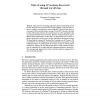Free Online Productivity Tools
i2Speak
i2Symbol
i2OCR
iTex2Img
iWeb2Print
iWeb2Shot
i2Type
iPdf2Split
iPdf2Merge
i2Bopomofo
i2Arabic
i2Style
i2Image
i2PDF
iLatex2Rtf
Sci2ools
PERVASIVE
2006
Springer
2006
Springer
Risks of Using AP Locations Discovered Through War Driving
Many pervasive-computing applications depend on knowledge of user location. Because most current location-sensing techniques work only either indoors or outdoors, researchers have started using 802.11 beacon frames from access points (APs) to provide broader coverage. To use 802.11 beacons, they need to know AP locations. Because the actual locations are often unavailable, they use estimated locations from war driving. But these estimated locations may be different from actual locations. In this paper, we analyzed the errors in these estimates and the effect of these errors on other applications that depend on them. We found that the estimated AP locations have a median error of 32 meters. We considered the error in tracking user positions both indoors and outdoors. Using actual AP locations, we could improve the accuracy as much as 70% for indoors and 59% for outdoors. We also analyzed the effect of using estimated AP locations in computing AP coverage range and estimating interferenc...
AP Locations | Applied Computing | Locations | Many Pervasive-computing Applications | PERVASIVE 2006 |
| Added | 14 Dec 2010 |
| Updated | 14 Dec 2010 |
| Type | Journal |
| Year | 2006 |
| Where | PERVASIVE |
| Authors | Minkyong Kim, Jeffrey J. Fielding, David Kotz |
Comments (0)

